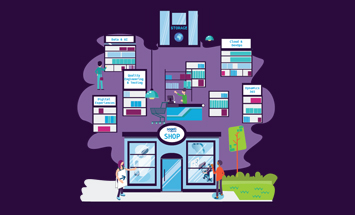The Next Normal
Jonas Hultenius, Software Architecht at Sogeti and one of our global experts in SogetiLabs dives into the topics digital transformation and the next new normal in our pre-pandemic work life. Read his blog here to find out more.
As the world emerges from the global pandemic, the landscape of work is undergoing a profound transformation. The experiences of widespread remote work during the pandemic have reshaped our perceptions of traditional office structures. While the commute to a distant office was a universally disliked aspect of pre-pandemic work life, the isolation and disconnection associated with remote work presented its own set of challenges. In envisioning the next new normal, a compelling concept emerges, micro commuting.
Micro commuting represents a shift away from the traditional model of commuting to a large central office. Instead, it involves commuting to a local, and possibly hyper-local, workspace. The goal is to combine the benefits of having a physical workspace with the flexibility and connectivity that remote work affords.
One of the fundamental realizations of the remote work experiment is that people crave connection. The isolation of working from home for extended periods left many feeling disconnected from their colleagues and the broader professional community. The local office, in this new paradigm, becomes a hub for social interaction, collaboration, and a sense of belonging.
The concept of micro commuting challenges the binary distinction between working from home and commuting to a central office. It introduces a middle ground where individuals can enjoy the advantages of a physical workspace without the burden of a long and arduous commute. The local office could be a shared workspace, a co-working facility, or even a community center adapted for work purposes.
Before the shift to remote work the workforce was centered around whatever location, city or region that had the need for them. During the pandemic, and for a lucky few even before that, the opportunity arose to work from any location you like and bring the work home with you. This necessary next step only bridges the gap in-between the different options. Work where you live, not live where you work! These new satellite offices should be placed where you expect to find new or already have old employs and can be centered around both cities, regions and even parts of a larger metropolitan area. This shift aligns with the growing emphasis on work-life balance. The local office, being close to home, reduces the time spent commuting, offering individuals more time for personal pursuits, family, and leisure. It addresses the dissatisfaction associated with spending hours on crowded trains or highways, providing a more sustainable and holistic approach to work.
Moreover, the local office becomes a focal point for building community and professional networks. It serves as a space where individuals from various organizations come together, fostering a vibrant local professional ecosystem. The social aspect of work is revitalized as individuals interact with colleagues, share ideas, and engage in spontaneous conversations, elements often lacking in remote work setups.
And in a shared space that spontaneous interaction does not have to be limited to only colleagues. I’m not suggesting that we should share our best kept secrets or important information with our competitors, but most companies are not in direct competition. So, by sharing and interacting, discussing and engaging with others we facilitate the bedrock for innovation and positive synergies.
Technology plays a pivotal role in enabling this hybrid model. Advanced communication tools, collaborative platforms, and virtual meeting solutions ensure that individuals can seamlessly connect with their remote colleagues and clients while benefiting from the advantages of a physical workspace. The local office becomes a node in a broader network, facilitating both in-person and virtual interactions.
We have tools today like Teams or Zoom but they are not really cutting it as they are more or less an extension of what Skype was twenties years ago. There is a need for something new, a holistic approach that transcends these tools and makes the physical offices directly interconnected with each other and the large part of the workforce that is working from home. I have some ideas, but that is another blogpost that is in the making, the digital office. Back to the next new normal!
Micro commuting would be applicable for most office work but is particularly suited for roles that require collaboration, creativity, and a sense of team cohesion. It allows for the best of both worlds, the autonomy and flexibility of remote work combined with the social dynamics and infrastructure of a physical workspace.
This model also addresses the challenges associated with remote work, such as feelings of isolation, difficulty in separating work and home life, and the erosion of organizational culture.
In conclusion, the next new normal in the world of work could very well be defined by micro commuting. This innovative approach embraces the lessons learned from the remote work experiment while recognizing the enduring value of physical workspaces. By creating local hubs that facilitate collaboration, connection, and community, micro commuting presents a compelling vision for the future of work – a future that combines the best elements of both remote and in-person work experiences.
- Jonas HulteniusSoftware Architect & SogetiLabs Fellow, Sogeti Sweden
070-518 66 25
 Jonas HulteniusSoftware Architect & SogetiLabs Fellow, Sogeti Sweden
Jonas HulteniusSoftware Architect & SogetiLabs Fellow, Sogeti Sweden
070-518 66 25






